My first year or two teaching I was very guilty of thinking that engaging science needed to involve some sort of complex science experiment. Thank goodness I learned a few years in that that was not true. I learned that drawing, designing, and even reflective discussions were a great way to engage my students in science topics we were studying.
Last week this was put into practice when we had the best time reviewing potential and kinetic energy with roller coasters. This activity was not a complex science experiment, but it was perfect at engaging my students in learning and showing what they know about a science topic. And my kids were almost as excited about this as they were the first time we played SCOOT. (By the way, we are addicted to SCOOT. We play it ALL the time, and the kids never even realize how much work they are doing! Click here to read a little more about SCOOT.)
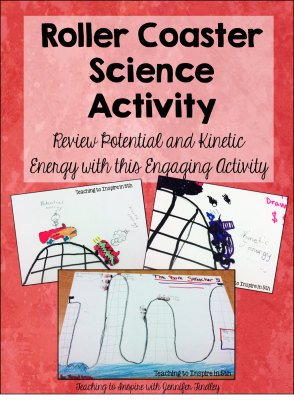
Back on track (no pun intended! :D), the activity was pretty simple but very powerful for my students’ application of what they had been learning about potential and kinetic energy. After a few days of direct instruction and a few simple demonstrations on potential and kinetic energy, we were ready to review with something more engaging and fun.
To begin with, each student individually sketched their roller coaster on their notes with these requirements:
- Must have at least two “hills”
- Must have two carts showing potential energy
- Must have two carts showing kinetic energy
- Must have the cart showing the most potential energy labeled
After the students independently sketched and labeled their drawing and I was able to informally assess them, I put them in small groups to plan and draw a group roller coaster, with the same requirements.
Check out the detail on these!
I love the name of this one!
The collaborative roller coaster aspect was a great add-on to the lesson. It got the students discussing the science skill and using the science vocabulary. It also allowed students who may not typically shine in group work to let their creativity and design skills show.
Want more resources for potential and kinetic energy? Click here to grab a FREEBIE from my TpT Store that includes several printables to supplement your instruction on potential and kinetic energy.
What is one simple, yet engaging activity you have done for science this year?
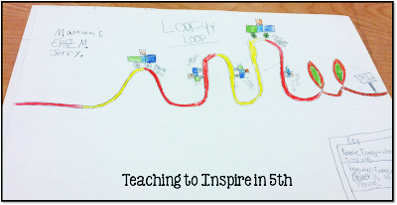

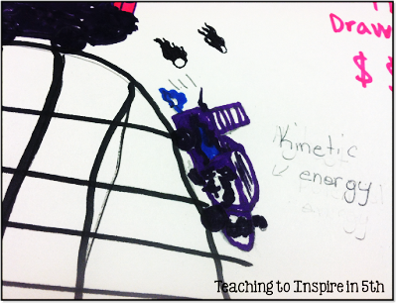
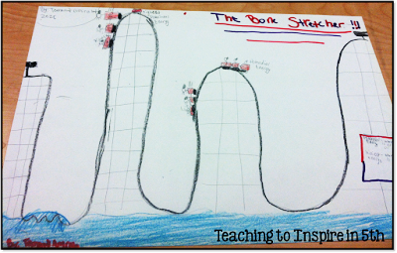
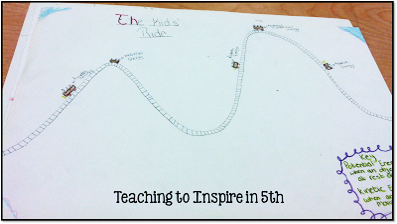







What a great idea! We acted out potential and kinetic energy in different situations…for example playing baseball, they had to show a position of potential energy and then show kinetic energy. It got them out of their seat so they enjoyed it!
Bethany
FabandFunin4th!
Love it! Thanks for sharing! We will have to try this tomorrow. 😀
I would have loved drawing roller coasters when I was in school! I don't teach science (teach history), but may next year. Hope to get more ideas from you!
Shannon
http://www.irunreadteach.wordpress.com
I don't get to teach history as much as I would like. I love history. 😀 Maybe one year I can focus more on history.
Definitely trying this! Thanks a bunch for sharing. I was wondering what is SCOOT? I could not find it anywhere on your site.
SCoot is a really fun game where you put a different question on each child's desk. The students SCOOT around to the other desks one a time (at the teacher's direction) and answer each question. I will post about it this week!
I'm totally using this next year!! Thanks for sharing.
You are welcome! We loved it!
Hi Jennifer I absolutely LOVE this!! Your kids must have had a blast! Fantastic way to remember potential/kinetic energy & way to take something that could possibly be very boring & make it VERY FUN!!
One simple yet engaging science activity I've done recently is my glitter water tension experiment – super easy, fun & really gets the point across!! I blogged about it on 3/22/13. Thanks again for sharing your awesome lesson!!
✿Sue✿
✿Science for Kids Blog✿
I am heading over to your blog now to check it out! Thanks for sharing!
What an awesome way to get kids excited (and remember!) potential and kinetic energy! I'm pinning this so I can remember it for my energy unit later this year.
Hi Jennifer, Can you explain your comment about "Highest Potential Energy vs. Most Potential Energy"?
I assumed highest and most both meant "greatest amount of", which would mean they are the same thing. Did you mean something else?